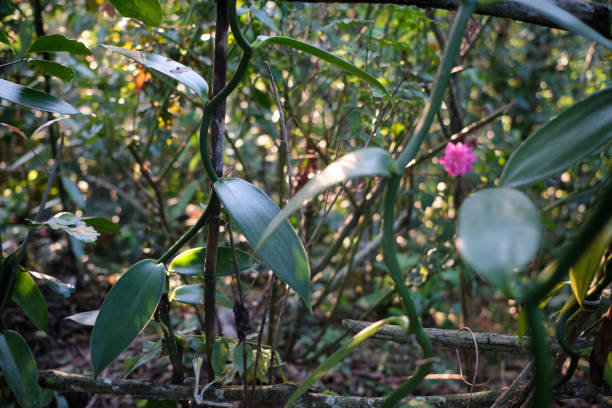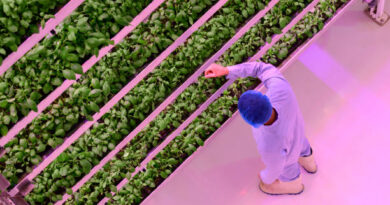Vanilla Production/ Vanilla Farming / Vanilla Health Benefits
Vanilla, a flavouring derived from the pods of orchid plants, has been used in traditional medicine for centuries. While more research is needed, here are some potential health benefits of vanilla:
- Antioxidant properties: Vanilla contains natural antioxidants, such as vanillic acid and vanillin, which can help neutralize harmful free radicals in the body.
- Anti-inflammatory properties: Some studies have suggested that vanilla may have anti-inflammatory effects, which could be helpful in managing conditions such as arthritis.
- Anxiety and stress relief: The scent of vanilla has been shown to have a calming effect on the brain, potentially reducing symptoms of anxiety and stress.
- Digestive health: Some people use vanilla as a natural remedy for digestive issues, such as nausea and vomiting.
- Improved mental performance: Preliminary studies have suggested that vanilla may have a positive effect on cognitive function, including memory and attention.
It’s important to note that more research is needed to fully understand the health benefits of vanilla, and vanilla-based products like vanilla extract and vanilla-flavored foods often contain added sugars or other additives that can be detrimental to health. If you’re interested in using vanilla for its potential health benefits, it’s best to consult with a healthcare professional first
Here’s an example of a use case for vanilla:
A person with arthritis is looking for natural remedies to help manage their symptoms. They read about the potential anti-inflammatory properties of vanilla and decide to incorporate it into their diet. They add a small amount of vanilla extract to their morning smoothie and use vanilla as a flavoring for desserts and baked goods. Over time, they notice a reduction in joint pain and stiffness, which they attribute to the anti-inflammatory effects of the vanilla.
In this case, the person has used vanilla as a complementary treatment for their arthritis, in combination with other approaches such as exercise, medication, and dietary changes. While more research is needed to confirm the anti-inflammatory effects of vanilla, this person’s experience suggests that it may be a helpful addition to an arthritis management plan for some individuals. It’s important to note that this is just one example, and the effectiveness of vanilla may vary depending on individual health conditions and other factors.
Vanilla ice cream

is a popular frozen dessert that is made with cream, sugar, and vanilla flavoring. It is a classic flavor that has been enjoyed for generations and is a staple in many ice cream shops and homes.
To make vanilla ice cream, the cream is heated with sugar until the sugar is dissolved. Then, the mixture is cooled and vanilla flavoring is added. The mixture is churned in an ice cream maker to incorporate air and create a smooth, creamy texture. Once the ice cream is churned, it is placed in a container and frozen until it reaches the desired consistency.
While vanilla ice cream is often enjoyed on its own, it also pairs well with a wide variety of toppings and mix-ins. Some popular options include hot fudge, caramel sauce, nuts, and fresh fruit. Additionally, vanilla ice cream is often used as a base for creating more complex flavors, such as mint chocolate chip or cookies and cream.
While vanilla ice cream is a delicious treat, it’s important to consume it in moderation as it is high in calories, sugar, and fat. Opting for small servings or lower-fat options can help make it a more balanced part of a healthy diet.
Vanilla Farming
Soil – humus-rich lateral soil with excellent drainage.
Climate
An annual rainfall of 150–300 cms in a humid tropical environment (well distributed for a period of 9 months and dry period of 3 months).
Latitude: 100 N and 200 S, elevation: 700–1500 m MSL
210 to 320 degrees Celsius.
Standards
Glyricidia sp., Casuarina equisetifolia, Erythrina indica, Jatropha curcus, and Plumeria alba.
planting in May and June, when the rainy season begins to end.
the planting season for vanilla
standards six months after planting (i.e.) October, September, and November

Propagation
60 to 120 cm long stem cuttings
Spacing
• Plains: 2.0 to 2.5 metres by 1.2 to 1.5 metres
Hills: 1.5 by 1.5 metres
Planting
For standards and planting vanilla cuttings, use a 30 cm3 pit. Place 2 nodes of unrooted cuttings should be buried 60–120 cm into the soil.
Training
Train the vines to 1.2–1.5 metres in height. then horizontally trained or permitted to grow down towards the earth. Around the pole that connects the two supporting trees are coiled horizontally trained vines. The same process is repeated each time a vine that has been trained to grow downward is permitted to touch the ground, root, and then be carried back upward on the same supporting tree.
Manuring
Up to three times every year, cover the vine with trimmed plants.
fertiliser dosage that is advised:
Apply 40 – 60: 20 – 30: NPK at a rate of 60–100 g per vine every year. There are two to three splits given. Once a month, apply a 1% solution of the 17: 17: 17 NPK mixture to the plant to promote growth and flower output.
Flowering
In the third year after planting, flowering begins in December or January. Flower bud initiation is aided by pinching the top 7.5–10 cm of the vine 6–8 months before the flowering season. Older fruiting branches can be pruned to promote the growth of flowers. Inflorescences have 15 to 20 flowers per inflorescence.
Sweet Flowers
Sweet Flowers
Pollination
Vanilla benefits from artificial pollination, which must be carried out on the same day that flowers begin to emerge at 4:00 am and last until 1:00 pm. A vine may have 10 to 20 inflorescences that can be pollinated.
The lower side of the inflorescence’s five to six flowers are often pollinated. Pollination by hand is Lifting the hood covering the anther cap with a toothpick, needle, or piece of sharp wood allows the anthers to come into touch with the stigma during hand pollination. 1000–1500 blooms can be pollinated by a qualified person each day.
Unripe Vanilla Beans
Unripe Vanilla Beans
Plant Defense
Pest
Feeding bugs, caterpillars, and leaf-eating beetles
spraying 0.05% quinolphos.
Diseases
fungus wilt
Rot results from an infection that originates in the leaf’s axil and moves to the nodal area.
• Applying 0.1% carbendazim via spraying and drenching.
• Adding organics also lessens the severity of the illness.
Rat Phytophthora
It makes beans, leaves, and stems decay.
spraying soil with 0.2% copper oxy chloride or 1% Bordeaux combination
Toxic sclerotium
It starts in the root tips and then spreads to the entire root system, causing the plant to yellow and wilt.
vines. Carbendazim soil soaking at 0.1%
Sclerotium rot and shoot tip rot
Carbendazim soil soaking at 0.1%
Harvesting
Six to nine months after blossoming, the pods are ready for harvest. The mature beans turn from green to a light golden colour. As the distal end of the pod turns yellow, it is time to pluck. It is crucial to collect mature pods every day. A knife is used to cut the pods for harvest.
Yield
A typical cured bean yield ranges from 300 to 600 kg per acre per year.
• 1 kg of cured beans are made from 6 kg of green pods.
Vine has an economic life of 12 to 14 years.


Pingback: PM Modi's Vision to make Self Sufficeant in Urea Production & Supply to Indian Farmers - Fresh To Fit
Pingback: Dragon fruit also known as ‘kamalam’ and ‘Pitaya’ in India - Fresh To Fit